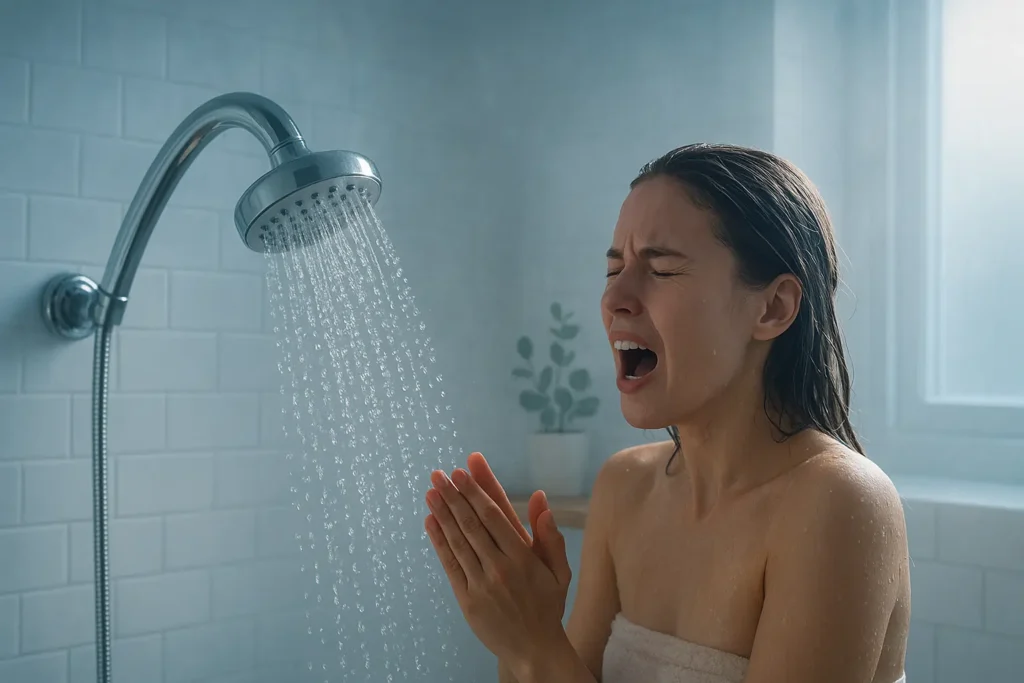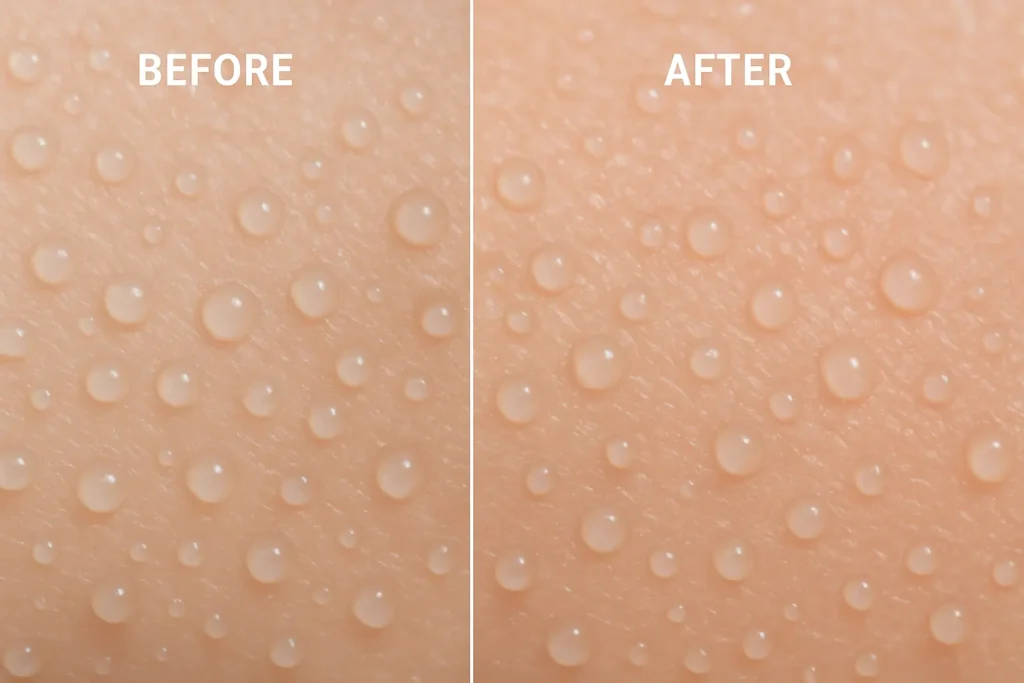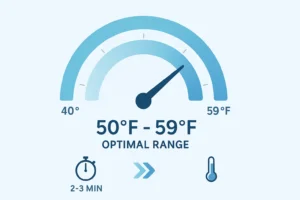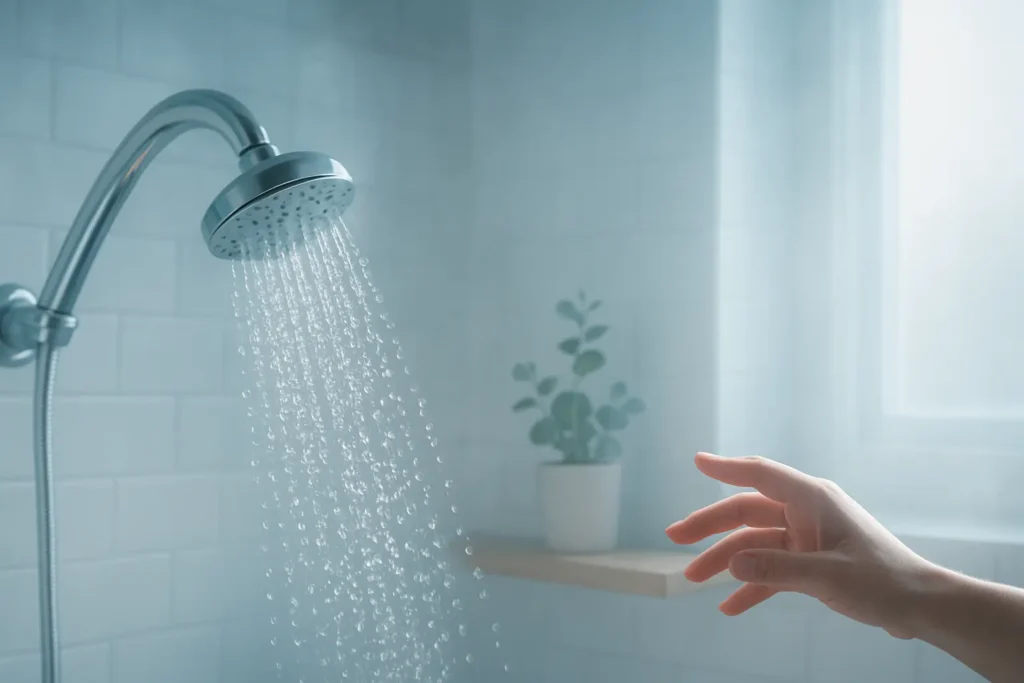Cold Water Baths for Glowing Skin: The Science Behind This 2025 Beauty Revolution
Morning That Changed My Perspective on Skincare

Three years ago, during a particularly humid summer in my clinic, I met a patient who completely shifted how I think about skincare basics. She was 68, with skin that honestly looked two decades younger. No fancy treatments. No $200 serums.
Her secret? Cold water. Every morning. For forty years.
I’ll admit—I was skeptical. After 18 years in medicine and specialized training in Cosmetic Formulation Science, I’d seen every trend come and go. But something about her conviction (and her skin) made me pause. That conversation sent me down a research rabbit hole that’s fundamentally changed how I approach skincare recommendations at Glow Guide Hub.
Here’s what I discovered: cold water therapy isn’t just some wellness fad. It’s grounded in legitimate physiological responses that dermatologists have been studying for decades. And in 2025, as we’re collectively exhausted by 12-step routines and products with ingredients we can’t pronounce, this simple practice is having its moment.
But let’s be real—not everything you’ve heard about cold water is accurate.
What Actually Happens When Cold Water Meets Your Skin

When cold water hits your face, your body doesn’t just sit there passively. It reacts. Fast.
The immediate response is vasoconstriction—your blood vessels tighten up. Think of it like your circulatory system doing a quick defensive maneuver. Blood moves away from your skin’s surface toward your core organs, which sounds counterintuitive for a skincare benefit, right?
Here’s where it gets interesting.
Once you step away from that cold water, your body reverses course. Blood vessels dilate, and suddenly there’s this rush of oxygenated, nutrient-rich blood flooding back to your skin. According to research published in the American Journal of Physiology, this process affects both central and peripheral hemodynamics, influencing blood flow patterns throughout recovery.
During my Cosmetic Science training, I learned that consistent, controlled temperature changes can stimulate what researchers call “vascular gymnastics”—essentially giving your circulatory system a workout. Your skin gets better at moving blood efficiently, which matters more than most people realize.
Blood carries everything your skin cells need: oxygen, nutrients, immune cells. Better circulation means better delivery. It’s not magic—it’s just physiology working in your favor.
But there’s a catch. (There’s always a catch.)
The research on long-term anti-aging benefits remains limited. While short-term effects like reduced puffiness and temporary pore tightening are well-documented, we can’t yet claim that cold water prevents wrinkles or significantly boosts collagen production over time. The studies just aren’t robust enough.
I mention this because honesty matters. As someone who’s reviewed quality control standards in cosmetic science, I’ve seen too many exaggerated claims. Cold water has real benefits—we don’t need to oversell it.
The Science Behind Cold Water and Circulation
Let me get slightly technical for a moment, then I’ll translate.
When skin temperature drops rapidly, your sympathetic nervous system activates. This triggers the release of norepinephrine, a neurotransmitter that causes smooth muscle contraction around blood vessels. That’s your vasoconstriction phase.
During rewarming, blood vessels dilate again as your nervous system releases the constriction response. This back-and-forth creates what researchers describe as improved vascular reactivity—essentially training your blood vessels to respond more efficiently to temperature changes. Studies published in the European Journal of Applied Physiology have documented this cold-induced vasodilation response and its cardiovascular effects.
Translation? Your blood vessels become more responsive and efficient at adjusting blood flow based on what your skin needs.
There’s also evidence that cold exposure can influence inflammatory responses. Research published in the International Journal of Hyperthermia found that cold water immersion can modulate cytokine production—those are the chemical messengers involved in inflammation. The study showed that even brief cold exposure affects TNF-α levels, one of the key inflammatory markers.
For someone dealing with morning puffiness or occasional redness, this matters. I’ve seen it work in my own routine, and several dermatology colleagues I’ve consulted confirm they’ve observed similar effects in patients.
However—and this is important—if you have rosacea, eczema, or extremely sensitive skin, cold water might irritate more than help. Always start conservatively, and if your skin protests, listen.
Real Benefits You Can Expect (Based on Research)
Let’s separate what’s scientifically supported from what’s hopeful thinking.
What Cold Water Can Realistically Do?
Temporarily tighten pores. The contraction caused by cold temperatures makes pores appear smaller for a short period. This isn’t permanent, but it creates a smoother appearance for a few hours. Perfect before makeup application or an important meeting.
Reduce morning puffiness. Cold causes vasoconstriction, which decreases fluid accumulation in facial tissues. This is why cold compresses work for puffy eyes—same principle, just applied to your whole face.
Calm inflammation. The anti-inflammatory response I mentioned earlier can help with redness, particularly if you’re dealing with irritation from other skincare products or environmental factors.
Enhance mental alertness. Not directly a skin benefit, but the cold shock activates your nervous system. Many people report feeling more awake and focused, which indirectly affects how you approach your entire morning routine.
What Cold Water Probably Won’t Do?
Permanently shrink pores. Pore size is largely genetic. You can’t fundamentally change it with temperature.
Significantly boost collagen production. While some studies suggest cold exposure might influence cellular metabolism, we lack solid evidence that cold water showers increase collagen synthesis enough to combat aging.
Replace your actual skincare routine. Cold water is a complement, not a substitute for sunscreen, retinoids, or moisturizers. If someone tells you otherwise, they’re selling something (and it’s probably not backed by dermatology research).
I’ve been incorporating cold water therapy for about two years now, paired with targeted products I’ve reviewed at Glow Guide Hub—including some excellent options for hydration (https://www.amazon.com/s?k=facial+moisturizer) and anti-aging support (https://www.amazon.com/s?k=anti-aging+serum). The combination works better than either approach alone.
How to Do It Right Without Shocking Your System

Here’s where most people mess up: they go too cold, too fast, and either hate it or potentially stress their cardiovascular system.
Start Here Instead
Begin with your normal shower temperature. Finish with just 10-15 seconds of cool (not ice-cold) water on your face. That’s it. You’re not trying to be a Navy SEAL—you’re conditioning your nervous system.
After three or four showers, extend to 20 seconds. Then 30. Gradually lower the temperature as your tolerance builds. This adaptation period matters because it allows your vascular system to adjust without triggering excessive stress responses.
Optimal Temperature Range
Most research suggests 50-59°F (10-15°C) provides benefits without unnecessary discomfort. You don’t need ice baths for skin benefits—save those for athletic recovery.
Duration
Two to three minutes on your face is plenty. Some wellness influencers promote 10-minute cold showers, but for skincare specifically, shorter exposures repeated consistently work better than occasional long sessions.
Timing
Morning works best for most people. The alertness boost helps start your day, and any redness from the cold exposure fades before you need to leave the house. Evening cold therapy can interfere with sleep for some individuals—your body temperature naturally drops to promote sleep, and cold exposure disrupts that pattern.
Breathing Technique
This isn’t yoga, but controlled breathing helps. Inhale deeply before the cold hits, then maintain steady breathing throughout. It calms your nervous system and makes the experience less jarring.
I’ve got patients with sensitive skin who started with just lukewarm water splashes and worked down over six weeks. There’s no rush. The goal is sustainable habit formation, not proving toughness.
One more thing—if you have cardiovascular conditions, Raynaud’s phenomenon, or you’re pregnant, consult your doctor before starting any cold therapy regimen. The vascular changes can affect people with certain situations differently.
Cold Water vs. Your Current Routine: An Honest Comparison
I’ll be straight with you: cold water isn’t replacing your retinol or vitamin C serum.
What it does is create an environment where those products potentially work better. Improved circulation means better nutrient delivery. Reduced inflammation means less interference with cellular repair processes. Tightened pores mean (temporarily) smoother texture.
Cost Comparison
A bottle of quality facial serum runs $40-120 and lasts maybe two months. Cold water costs nothing beyond what you’re already paying for utilities. From a cost-effectiveness standpoint, there’s no competition.
Time investment
Most skincare routines take 5-10 minutes morning and night. Adding cold water therapy adds maybe 2-3 minutes to your morning shower—minimal time investment for measurable results.
Long-term considerations
Chemical treatments can cause sensitization over time. You might need to switch products, increase concentrations, or deal with unexpected reactions. Cold water doesn’t build tolerance in the same way—your body adapts, but it continues responding to the temperature stimulus.
That said, chemical treatments target specific concerns (hyperpigmentation, acne, fine lines) with active ingredients that have decades of research behind them. Cold water is more general-purpose maintenance.
Think of it this way: cold water therapy is like regular exercise for your skin’s circulatory system. Targeted treatments are like physical therapy for specific issues. You probably need both, just like you need both general fitness and injury-specific rehabilitation.
At Glow Guide Hub, I recommend pairing cold water with evidence-based products. For example, following cold therapy with a quality eye serum (https://www.amazon.com/s?k=eye+serum+dark+circles) addresses both general circulation and specific concerns like dark circles.
What to Pair With Cold Water Therapy
Cold water works better when it’s part of a holistic approach. After reviewing countless products and studying cosmetic formulation science for years, here’s what actually complements this practice:
Immediate Follow-Up
After cold water exposure, your skin is primed to absorb products. Apply while still slightly damp. I typically use a hydrating serum first, then moisturizer to lock everything in. The temporary increase in blood flow may enhance ingredient penetration.
Nutrition That Matters
Omega-3 fatty acids (found in salmon, walnuts, flaxseed) support the cell membrane integrity that makes circulation benefits more effective. Vitamin C aids collagen synthesis—if cold water is stimulating cellular activity, you want the raw materials available. Antioxidants (berries, green tea, dark chocolate) help manage oxidative stress from environmental factors.
Hydration Strategy
Seems obvious, but most people are chronically under-hydrated. Aim for half your body weight in ounces daily. For someone who weighs 150 pounds, that’s 75 ounces of water. Better hydration means better skin plumpness and more effective circulation.
Sleep Quality
This might seem unrelated, but cellular repair happens primarily during deep sleep. If you’re doing cold water therapy to support skin health but only sleeping five hours nightly, you’re undermining your efforts. Aim for 7-9 hours consistently.
Complementary Products
Based on my experience and training in product development, these categories pair well with cold water therapy:
- Gentle, pH-balanced cleansers that won’t strip your skin before cold exposure
- Niacinamide serums that support barrier function (https://www.amazon.com/s?k=niacinamide+serum)
- Rich moisturizers that seal in hydration after cold therapy
- Broad-spectrum sunscreen (non-negotiable, regardless of your routine)
Exercise Synergy
Regular cardiovascular exercise enhances the circulatory benefits you’re getting from cold water. You’re essentially training your vascular system from two angles. I’ve noticed more pronounced effects since combining morning cold therapy with 3-4 weekly cardio sessions.
One patient combination that’s worked remarkably well: cold water therapy, a simple routine with cleanser and moisturizer, weekly gentle exfoliation, and consistent sunscreen use. Sometimes less really is more—you’re just doing that “less” more intentionally.
What About Different Skin Types?
Not everyone should approach cold water therapy identically.
Oily/Acne-Prone Skin
Generally responds well. The temporary pore tightening and anti-inflammatory effects can reduce the appearance of breakouts. However, if you’re on strong acne medications like isotretinoin, your skin might be more sensitive to temperature extremes. Start gradually.
Dry Skin
Cold water preserves natural oils better than hot water (which strips them), so this can actually help. Just make sure you’re moisturizing immediately after. Look for ceramide-rich products (https://www.amazon.com/s?k=ceramide+moisturizer) to support barrier repair.
Sensitive/Rosacea-Prone Skin
This is where caution matters most. For some people, cold water calms redness. For others, the temperature change triggers flushing. Test with cool water first, not cold. If you see sustained improvement over a week, continue. If redness worsens, this isn’t your technique.
Mature Skin
The circulation boost can create a temporary glow, but remember that cold water isn’t addressing the fundamental causes of aging (collagen breakdown, elastin loss, cumulative sun damage). Pair it with proven anti-aging ingredients like retinoids and peptides for actual results.
Combination Skin
Usually tolerates cold water well. You might find it particularly helpful on your T-zone, where oil production tends to be higher.
I’ve got 18 years of clinical experience, and here’s what I’ve learned: individualization matters more than universal protocols. Your skin’s response is the ultimate guide.
The Real Talk About Limitations
Let’s address what cold water therapy isn’t.
It won’t cure acne. It won’t eliminate wrinkles. It won’t fade hyperpigmentation. It won’t replace medical-grade treatments for serious skin conditions.
What it will do is support your skin’s natural functions—circulation, inflammation management, temporary pore appearance—in a way that’s free, accessible, and has minimal risk when done sensibly.
I mention this because the wellness industry has a bad habit of taking legitimate practices and overclaiming their benefits. Cold water immersion has real research behind it, but that research doesn’t support some of the wild claims floating around social media.
From my background in regulatory standards for cosmetic science, I can tell you that if a product made some of the claims attributed to cold water, it would need FDA approval as a drug. The fact that cold water is just water doesn’t mean we should abandon scientific rigor when discussing its effects.
Be skeptical of anyone promising a dramatic transformation from any single practice, whether it’s cold water, a miracle serum, or a trendy device. Skin health is multifactorial—genetics, environment, lifestyle, targeted treatments, and yes, simple practices like cold water all play roles.
FAQ: Cold Water Baths for Glowing Skin
Can Cold Water Therapy Replace My Moisturizer?
No. Cold water affects circulation and temporarily tightens pores, but it doesn’t provide the lipids, humectants, and occlusives your skin barrier needs. Always moisturize after cold water exposure.
How Long Until I See Results?
Most people notice reduced puffiness immediately and improved texture within 1-2 weeks. Long-term circulation benefits develop over months of consistent practice—think 8-12 weeks for noticeable vascular improvements.
Is Cold Water Safe During Winter?
Yes, but be more gradual with temperature changes when ambient air is already cold. Your body’s working harder to maintain core temperature, so extreme cold exposure adds unnecessary stress.
Can I Use Ice Directly on My Face Instead?
Ice can cause cold burns and potential capillary damage if applied too long or directly. Cool water is safer and more controllable than direct ice application for daily practice.
Does Cold Water Help With Dark Circles?
Temporarily, yes—it reduces fluid accumulation and puffiness under eyes. However, dark circles from genetics or hyperpigmentation require targeted treatments like vitamin C serums or caffeine-based products (https://www.amazon.com/s?k=eye+cream+dark+circles).
Should I Use Cold Water Morning and Night?
Morning is generally better. Evening cold exposure can interfere with your body’s natural temperature drop that promotes sleep. One daily session is sufficient for most people.
Can Cold Water Damage My Skin Barrier?
Not typically. Hot water damages barriers by stripping oils; cold water preserves them. However, if you notice increased dryness, reduce frequency or duration.
What If I Have Eczema or Psoriasis?
Consult your dermatologist first. Some people with these conditions find cold water soothing; others experience flare-ups. Individual response varies significantly with inflammatory skin conditions.
How Cold Is Too Cold?
Below 40°F (4°C) approaches uncomfortable cold shock territory without additional skin benefits. The 50-59°F range provides optimal benefits with manageable discomfort.
Can Kids Do Cold Water Therapy?
Children’s thermoregulation systems are less developed. Gentle cool water is fine, but avoid cold shock techniques for children under 12 without a pediatrician’s guidance.
The Bottom Line: Should You Try It?
After two years of personal experimentation, extensive research during my cosmetic science training, and observing results in patients who’ve adopted this practice, here’s my take:
Cold water therapy is worth trying if you’re looking for a simple, evidence-based addition to your routine. It won’t replace targeted treatments, but it provides legitimate circulatory and anti-inflammatory benefits that support overall skin health.
Start conservatively. Be consistent. Manage expectations. And remember that skincare is personal—what works remarkably for one person might be neutral for another.
At Glow Guide Hub, we’re committed to cutting through the noise and providing honest, research-backed guidance. Cold water therapy fits that philosophy: it’s simple, accessible, and grounded in physiology rather than marketing hype.
Your skin is with you for life. Treating it well doesn’t always require complexity or expense—sometimes it just requires paying attention to the fundamentals we’ve overlooked.
Now if you’ll excuse me, I’ve got a morning shower calling my name. And yes, I’ll be ending it with cold water.
Disclaimer: GlowGuideHub participates in the Amazon Services LLC Associates Program, an affiliate advertising program designed to provide a means for sites to earn advertising fees by advertising and linking to Amazon.com. As an Amazon Associate, I earn from qualifying purchases. If you click on an Amazon link on my site and make a purchase, I may earn a commission at no additional cost to you.

